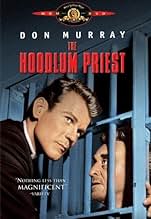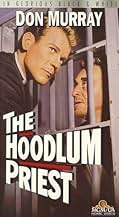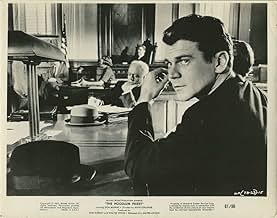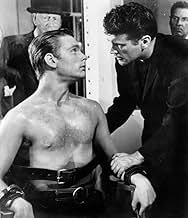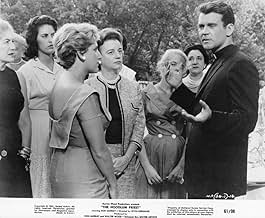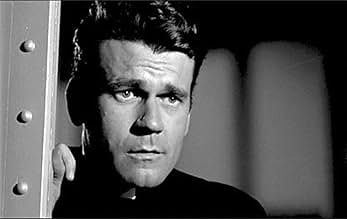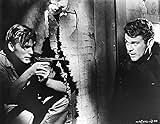VALUTAZIONE IMDb
6,6/10
517
LA TUA VALUTAZIONE
Aggiungi una trama nella tua linguaBased on the life of Fr. Charles Clark, a minister to street gangs.Based on the life of Fr. Charles Clark, a minister to street gangs.Based on the life of Fr. Charles Clark, a minister to street gangs.
- Regia
- Sceneggiatura
- Star
- Premi
- 2 vittorie e 1 candidatura in totale
Norman McKay
- Father Dunne
- (as Norman MacKaye)
Walter L. Wiedmer
- Father David Michaels
- (as Walter Wiedmer)
Recensioni in evidenza
Irv Kerschner, who was George Lucas' teacher at USC and later directed one of his pupil's Star Trek features, made this glossy well-meaning melodrama released by United Artists in 1961. Shot on location in St. Louis and featuring the semi-documentary but often overly self-conscious B&W cinematography of Haskell Wekler, the story is based on the real life story of a Jesuit priest --perhaps the first man in America to set up a half-way house for ex-cons. Although its heart is in the right place, and the film makes the plea that the criminal justice system in the United States only serves to criminalize young offenders rather than reform them, Kershner cannot resist all the obvious opportunities to be arty: chases through railroad yards and into abandoned buildings with broken furniture and boarded-up windows providing the right shadows on the wall. He also hammers home his point by squeezing out the last drop of melodrama from the shaky plot, including a totally implausible electric chair sequence with the priest admitted into the chamber as his hoodlum friend is about to be electrocuted. The film tries to have its cake and eat it, too. In real life the Irish priest was helped to build his halfway house by a Russian-Jewish immigrant attorney, Morris Shenker, but the film homogenizes their relationship; the young offenders somehow feel as if they dropped out of "West Side Story," made the same year, because they were unable to sing and dance.
The true story of Jesuit priest Father Charles Dismas Clark and his struggles in opening a halfway house for recently-paroled convicts in '50s-era St. Louis. Lead actor Don Murray (who also co-produced the film and co-wrote the screenplay under a pseudonym) was reportedly inspired to tackle this project after meeting the real Father Dismas Clark, who is credited as technical adviser; still, one can see right away how this production got funded, what with a violent police standoff in the third act, capped with a dramatic gas chamber sequence. Despite talented Irvin Kershner as director and Haskell Wexler as cinematographer, the picture isn't any more weighty or profound than the juvenile delinquent programmers of the previous decade. Keir Dullea makes a strong debut as a troubled youth, but Murray and the other cast members generally fail to impress. *1/2 from ****
I am 75 years of age and I remember seeing the movie sometime when it came to TV. It was not my sort of movie then or now. I could not recommend this movie to anyone today.
I do think however that Don Murray, as Father Clark, did some great acting in this movie.
I started my freshman year at a Catholic high school, De La Salle Military Academy, in 1955. The entire first week was a Catholic retreat (religion). I can not remember now if Father Clark did one day of the retreat or the entire week. I seem to think he did the entire week.
I was 14 years old and a Catholic and had gone to only Catholic schools. I had never heard of Father Clark.
As soon as I saw and heard Father Clark I was thinking this guy is crazy. I was thinking why are the Christian Brothers allowing a crazy man to be around a bunch of kids?
Later they had confession and I was sent into a room, alone, with Father Clark to hear my confession. He grabbed me and started to wail or say something about it will be OK or something like that. I did the confession thing and got the hell out of there.
I think the movie got a lot correct about Father Clark. But if they had shown the real Father Clark it would have been a much different movie and I do not think it would have been shown.
But if you want to get a little bit of an idea about what Father Clark was like then the movie and Don Murray do a pretty good job of it.
I do think however that Don Murray, as Father Clark, did some great acting in this movie.
I started my freshman year at a Catholic high school, De La Salle Military Academy, in 1955. The entire first week was a Catholic retreat (religion). I can not remember now if Father Clark did one day of the retreat or the entire week. I seem to think he did the entire week.
I was 14 years old and a Catholic and had gone to only Catholic schools. I had never heard of Father Clark.
As soon as I saw and heard Father Clark I was thinking this guy is crazy. I was thinking why are the Christian Brothers allowing a crazy man to be around a bunch of kids?
Later they had confession and I was sent into a room, alone, with Father Clark to hear my confession. He grabbed me and started to wail or say something about it will be OK or something like that. I did the confession thing and got the hell out of there.
I think the movie got a lot correct about Father Clark. But if they had shown the real Father Clark it would have been a much different movie and I do not think it would have been shown.
But if you want to get a little bit of an idea about what Father Clark was like then the movie and Don Murray do a pretty good job of it.
A visit to the other side of the tracks is what to expect here keeping mind that this could be the story of anyone young, misguided and lost without direction and surrounded by temptation and hopelessness. With that mind, watch how everything can wrong (Murphy's law) and then some. This movie also takes us to the fine line of choice and how in a moment of weakness or impulse, one bad choice can bring your whole life crashing down. Can't happen to you...you say? That's who visits with first. Also anyone that has lived knows the truth of this statement. How many times have we all said to ourselves: there go I but for the grace of God? The movie drives this point home too. Ten cents or ten million, all face the same problems and at the same time all of us have the same remedy too i.e. HOPE. If you add prayer to that and a sincere effort, you can rise above just about anything. Why? We were not put here to be defeated. Some really good dialog and scenes that try to reach for your emotions. Let them! One more thing. If someone has nothing and they offered anything and that offer should be respected even if your ...
After having just viewed a nice sharp B&W 16mm theatrical print of this fine film, I must say; Don Murray's production of HOODLUM PRIEST really deserves to be given serious consideration by cinephiles looking for hard-hitting drama about an important social issue that still has relevance today. It surpassed my expectations for a film having a title better suited to cheaper exploitation fare. Even within a very tightly budgeted film, ace cinematographer Haskell Wexler was able to impart some really nice arty touches with seedy shadowy lighting schemes and the occasional off-kilter frame compositions. There were solid performances all around with the two standouts being Don Murray and Kier Dullea. Irvin Kirshner proves once again that he is quite a solid director with a marked talent for mixing heavy drama with realism. The near final scene in the prison is such a gut-wrenching experience, you'll feel as if you are really there witnessing a mind-numbing horror played so effectively by the young Dullea. So, please dismiss the weaker reviews here and seekout HOODLUM PRIEST, a real hidden gem.
Lo sapevi?
- QuizConcerned that the critics would not be kind to an actor appearing in a film he wrote, Don Murray penned the screenplay under the pseudonym "Don Deer", his nickname as a track and field athlete in high school in Rockaway, NY.
- ConnessioniReferenced in Comunione con delitti (1976)
I più visti
Accedi per valutare e creare un elenco di titoli salvati per ottenere consigli personalizzati
Dettagli
- Data di uscita
- Paese di origine
- Lingua
- Celebre anche come
- The Hoodlum Priest
- Luoghi delle riprese
- 301 East State Street, Jefferson City, Missouri, Stati Uniti(Missouri-Pacific Railroad train station)
- Azienda produttrice
- Vedi altri crediti dell’azienda su IMDbPro
Botteghino
- Budget
- 600.000 USD (previsto)
- Tempo di esecuzione1 ora 41 minuti
- Colore
- Proporzioni
- 1.66 : 1
Contribuisci a questa pagina
Suggerisci una modifica o aggiungi i contenuti mancanti



